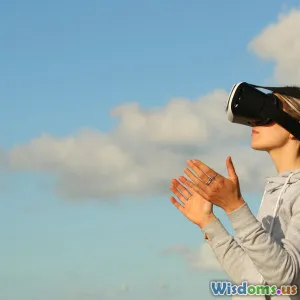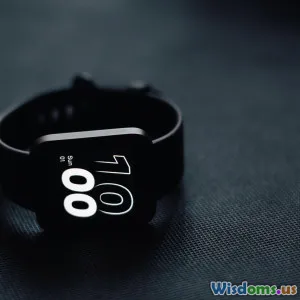
Augmented Reality Use in Retail Skyrocketing This Year
10 min read Explore the rapid rise of augmented reality in retail and how it's transforming customer experiences and boosting sales in 2024. (0 Reviews)
Augmented Reality Use in Retail Skyrocketing This Year
Introduction
Imagine walking into a store, pointing your smartphone at a pair of shoes, and instantly seeing how they zoom onto your feet without trying them on. Or visualizing that new sofa in your living room right from your couch. What was once futuristic fantasy is now fast becoming an everyday reality—thanks to augmented reality (AR). In 2024, retail is undergoing a profound transformation fueled largely by the skyrocketing adoption of AR technology. This year marks a pivotal moment where AR has moved beyond novelty into essential customer experience, radically reshaping how consumers shop and how retailers engage customers.
In this article, we unravel the explosive rise of augmented reality in the retail sector, delve into the technology's practical uses, analyze compelling data on its growth, and showcase real-world examples that prove this is not a passing trend but a new retail imperative.
The Retail Landscape: Why AR Adoption Is Exploding
The retail industry, long challenged by e-commerce pressures and shifting consumer demands, is turning to AR for unique solutions. According to a recent report from Grand View Research, the augmented reality market in retail is projected to reach over $6 billion by 2027, growing at an astonishing compound annual growth rate (CAGR) of 40%. The surge in AR adoption is driven by multiple key factors:
-
Consumer Demand for Immersive Experiences: Modern shoppers crave interaction and personalization. They want to "try before they buy" even when shopping online.
-
Pandemic-Related Shopping Habits: COVID-19 accelerated e-commerce but also emphasized a need for better digital shopping tools that mimic in-store experiences.
-
Technological Advances: More affordable AR devices, improved smartphone capabilities, and powerful AR software platforms have reduced barriers for retailers.
-
Competitive Differentiation: AR offers a fresh way to engage customers, build brand loyalty, and increase conversion rates.
This confluence notably explains why 2024 has become a pivotal year for AR in retail.
Core Applications of AR Transforming Retail
1. Virtual Try-Ons
One of the most impactful AR applications is virtual try-ons, where customers virtually "wear" apparel, shoes, glasses, or makeup via their smartphones or in-store AR mirrors. Gucci leveraged AR through its Gucci Sneaker Try-On app, which allows users to overlay sneakers onto their feet using smartphone cameras. This initiative resulted in measurable uplift in engagement and sales.
The cosmetics industry is another early AR adopter. Brands like L’Oréal with its ModiFace technology let customers virtually apply makeup shades and hair colors. This approach reduces product waste, boosts purchase confidence, and enhances customer satisfaction.
2. Immersive Product Visualization
AR enables shoppers to visualize large products in their own environments. IKEA's Place app is a shining example—offering users the ability to place highly accurate digital models of furniture into their real living spaces before buying. The app has been credited with increasing purchase confidence and reducing returns by up to 20%.
Similarly, automotive retailers are integrating AR to showcase vehicles. For example, Hyundai's AR showroom lets prospective buyers view car models from every angle and simulate features such as opening doors or changing colors right from their mobile devices.
3. Interactive In-Store Experiences
Physical retail is also evolving with AR-driven innovation. Stores are integrating AR-enabled mirrors, displays, and apps to offer personalized shopping interactions. Sephora's Virtual Artist tool is deployed both in-app and instore, giving customers interactive tutorials and instant virtual tests.
Zara recently tested AR windows in multiple locations where customers could scan QR codes to see virtual models wearing the latest collection, creating buzz and increasing foot traffic.
4. Enhanced Product Information and Navigation
AR can overlay detailed product info and ratings, helping customers make smarter and quicker decisions. Lowe’s introduced the “Lowe’s Vision” app allowing customers to see helpful product specifications and DIY tutorials via AR as they browse the store aisles.
Meanwhile, large retail spaces like Walmart started pilot AR navigation tools, guiding customers to products through visual cues, enhancing convenience and reducing shopping time.
Data-Driven Evidence of AR Retail Success
The numbers speak loudly. A 2023 survey by Deloitte revealed that over 70% of consumers prefer retailers offering AR experiences over those who don't, with 40% saying they are more likely to purchase after engaging with AR.
Conversion rates tell a compelling story too. Brands report up to a 40% higher conversion rate when AR elements are integrated into their shopping journey. Additionally, average order values tend to increase by 25% or more, as customers often explore more products through immersive AR tools.
Retailers integrating AR also see notable reductions in product return rates—thanks primarily to more accurate visualizations and better informed purchases at the outset.
Real-World Insights: Experts and Industry Voices
According to Forrester Analyst Anne Zelenka, "Augmented reality is rapidly shifting from a marketing gimmick to a full-fledged commerce channel. Retailers who don’t embrace this change risk losing relevance, especially as younger digital-native shoppers expect these capabilities."
Nick Bell, CEO of AR Innovator Varjo, notes, "As AR hardware becomes wearables and glasses rather than just phone cameras, the blending of the physical and digital retail world will deepen dramatically, creating new consumption paradigms."
Global retail leaders are substantial investors too. Walmart, Amazon, and Sephora have expanded their AR features significantly in 2024, interpreting benefits not only in revenue but in brand innovation and customer loyalty.
Challenges and Considerations Moving Forward
Despite the rosy outlook, AR retail adoption faces hurdles:
-
Development Cost and Complexity: High-quality AR experiences often require substantial investment.
-
Consumer Privacy: Collecting data to personalize AR experiences must be balanced with privacy concerns.
-
Hardware Limitations: While smartphone AR is accessible, high-end immersive AR requires devices not yet widespread.
Retailers and tech companies are actively dismantling these barriers with cheaper platforms, better SDKs, and robust privacy frameworks.
Conclusion
The retail sector in 2024 stands witness to a transformational surge in augmented reality applications. The technology's power to enhance shopping experiences, boost sales, and increase customer delight has turned AR into an indispensable retail tool rather than a novelty. From virtual try-ons and product visualization to enriched in-store digital touchpoints, AR is syncing perfectly with consumer expectations and technological readiness.
For retailers willing to embrace this fast-evolving field, the rewards are substantial—not just in revenues, but in redefined customer connections and future-proofing their business. For shoppers, augmented reality offers an exciting glimpse into a personalized, seamless, and interactive retail journey that is only set to grow richer.
Investing time and resources in understanding and adopting AR now is not just visionary—it's essential for staying competitive in an increasingly digital marketplace.
References
- Grand View Research, "Augmented Reality Market in Retail, 2024-2027"
- Deloitte Global Mobile Consumer Survey, 2023
- IKEA Place App Case Study
- Gucci Sneaker AR Experience Data Report
- Forrester Research, Analyst Insights 2024
- Varjo CEO Interview, May 2024
- Walmart and Sephora AR Initiatives Press Releases
Explore AR in retail today—an immersive future awaits!
Rate the Post
User Reviews
Popular Posts



















